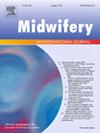Pregnancy, risk behaviors and adverse reproductive outcomes: Is preconception care working in Italy?
IF 2.6
3区 医学
Q1 NURSING
引用次数: 0
Abstract
Background
Preconception care guidelines and recommendations have been developed in many countries but, in Europe, recommendations for healthy couples are fragmented and not yet suitably implemented.
Objectives
Our objective was to investigate, in a sample of Italian women who gave birth healthy babies in Northern Italy, the prevalence of performing preconception visit and the rate of risks and protective behaviours on adverse pregnancy outcomes, according to preconception visit.
Materials and Methods
The study was a cross-sectional survey conducted in four maternity clinics in Northern Italy. After birth, women were asked to fill in a self-administered questionnaire on general characteristics, preconception visit, protective and risk factors (folic acid, immunization, BMI, smoking, alcohol, chronic diseases) before and during pregnancy.
Results
1077 women completed the questionnaire and were included in the analysis; 381 (35.4 %) underwent a preconception visit. Folic acid intake was significantly higher in the Preconception Visit Group (OR = 3.94, 95 % CI 2.7–5.7 and OR = 2.27, 95 % CI 1.7–3.1 - at least six months and one month before the last menstruation until the end of the first trimester - respectively). An increased number of women were vaccinated for rubella and chickenpox, had a BMI between 18.50–24.99 and were not smokers before pregnancy in the Preconception Visit Group.
Conclusions
Our survey showed a limited use of the preconception visit among Italian women. It may represent a valid resource to improve the folic acid supplementation and immunization before pregnancy. More evidence is needed regarding the role of preconception visit on the risk factors requiring an integrated and long-term approach.
妊娠、危险行为和不良生殖结果:孕前护理在意大利有效吗?
背景:许多国家都制定了孕前护理指南和建议,但在欧洲,针对健康夫妇的建议是零散的,尚未得到适当实施。我们的目的是调查在意大利北部生育健康婴儿的意大利妇女样本中,根据孕前访问,进行孕前访问的流行程度以及对不良妊娠结局的风险和保护行为的比率。材料与方法本研究是在意大利北部四家产科诊所进行的横断面调查。出生后,妇女被要求填写一份自我管理的问卷,内容涉及一般特征、孕前访问、保护和风险因素(叶酸、免疫、体重指数、吸烟、饮酒、慢性病)。结果1077名女性完成问卷并纳入分析;381例(35.4%)接受了孕前检查。产前访问组的叶酸摄入量明显更高(OR = 3.94, 95% CI 2.7-5.7和OR = 2.27, 95% CI 1.7-3.1——分别是在最后一次月经前至少6个月和1个月,直到孕早期结束)。在孕前访问组中,接种风疹和水痘疫苗的妇女人数增加,体重指数在18.50-24.99之间,怀孕前不吸烟。结论我们的调查显示意大利妇女孕前访问的使用有限。它可能是一个有效的资源,以提高叶酸的补充和孕前免疫。需要更多的证据证明孕前检查对需要综合和长期方法的危险因素的作用。
本文章由计算机程序翻译,如有差异,请以英文原文为准。
求助全文
约1分钟内获得全文
求助全文
来源期刊

Midwifery
医学-护理
CiteScore
4.50
自引率
7.40%
发文量
221
审稿时长
13.4 weeks
期刊介绍:
Midwifery publishes the latest peer reviewed international research to inform the safety, quality, outcomes and experiences of pregnancy, birth and maternity care for childbearing women, their babies and families. The journal’s publications support midwives and maternity care providers to explore and develop their knowledge, skills and attitudes informed by best available evidence.
Midwifery provides an international, interdisciplinary forum for the publication, dissemination and discussion of advances in evidence, controversies and current research, and promotes continuing education through publication of systematic and other scholarly reviews and updates. Midwifery articles cover the cultural, clinical, psycho-social, sociological, epidemiological, education, managerial, workforce, organizational and technological areas of practice in preconception, maternal and infant care.
The journal welcomes the highest quality scholarly research that employs rigorous methodology. Midwifery is a leading international journal in midwifery and maternal health with a current impact factor of 1.861 (© Thomson Reuters Journal Citation Reports 2016) and employs a double-blind peer review process.
 求助内容:
求助内容: 应助结果提醒方式:
应助结果提醒方式:


